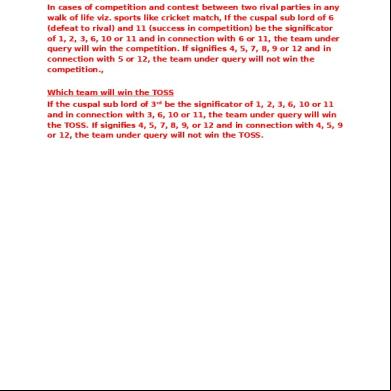Chloroplast 503b64
This document was ed by and they confirmed that they have the permission to share it. If you are author or own the copyright of this book, please report to us by using this report form. Report 2z6p3t
Overview 5o1f4z
& View Chloroplast as PDF for free.
More details 6z3438
- Words: 914
- Pages: 20
Chloroplast
Plastids: Present in all living plants and a protozoan named Euglena as well Plastids are discoid or spherical Contain multiple copies of DNA & 70S type ribosome
Historical aspects:Described by Grew and Leeuwenhoek.
Term was coined by Schimper in 1885 And he also classified the plastids Detailed cytological studies were carried out by Schimper, Schmitz & Meyer (1884-85)
Wilstatter & Stoll (1918) isolated Chl a and Chl b
Emerson and Arnold (1932) based on flashing light expt showed the existence of light & dark reactions Ruben & Kamen (1941) demonstrated by the use of O18 isotopic studies that O2 liberated comes from water.
Types of Plastids:1. Leucoplasts:- colourless plastids found in the germ cells and embryonic cells. Also found in the meristematic regions of plant not receiving light True leucoplasts occur in fully developed plant cells True leucoplasts do not contain thylakoids and ribosomes
Leucoplasts store food material as carbohydrates and hence are classified as follows:A. Amyloplasts:-Synthesize & store starch;the outer membrane of amyloplasts contain one to eight starch granules; in potatoes, starch granule is arranged in concentric rings & grow as big as an animal cell. B. Elaioplasts:-Store lipids (oils) in the seeds of monocots & dicots. They also include sterol-rich Sterinochloroplasts.
C. Proteinoplasts:- Occur in protein storing seeds & also contain few thylakoids 2. Chromoplasts:- Round, ellipsoidal or needle- shaped and the carotenoids they contain are in the form of droplets or crysta lline structure. Their major function is to attract insects for Pollination in flowers. Red tomatoes have Lycopene:- a chromoplast
Chromoplast of blue-greens contain Phycocyanin, Phycoerythrin, chlorophyll a and carotenoids Chromoplasts are of following 2 types:a. Phaeoplast:-contains dark brown pigment fucoxanthin, which has light absorbing property. Examples are Phaeophycea, daitoms and Dinoflagellates b. Rhodoplast:-contains the pigment phycoerythrin, Examples are rhodophyceae. 3. Chloroplast:Most widely occurring chromoplast of the plants Presence of chl a and b along with DNA & RNA in chloroplasts
A/c to Schimper, different kinds of plastids can get transformed into one another as follows:-
Leucoplasts
Chloroplasts
Chromoplasts
Development of Plastids:-
All plastids develop from Proplastids (available in meristematic cells) Proplastids develop into types of plastid as per requirement of the cell type Light dependent action of phytochrome is responsible for development of chloroplasts
Phytochrome:- a protein with 1.24kDa molecular wt
This protein contains one pigment which can exist in two interconvertible forms:- an inactive form, produced by far-redlight and active form, produced by the red light. Mediate light-mediated responses including plastid differentiation, chloroplast rotation, seed germination etc.
Chloroplasts:- Biological significance: Most common plastids of green plants Important b/o photosynthetic activities Homogeneously distributed in cells of plants In some algae, distributed around the nucleus or just beneath the plasma membrane Chloroplasts are motile organelles showing ive and active movements Higher chloroplasts are bi-convex or planoconvex, varying in shape in different cells, e.g., Spheroid, discoid, spiral etc.
In size, chloroplasts vary from 2 to 3µm in thickness & 5 to 10 µm in diameter. Plants grown in shade have larger chloroplasts than the ones growing in the sun. No (20 to 40) varies from cell to cell, however, Remains constant in one type of cell.
Comparison with mitochondria:1. Less permeable outer membrane, similar to mito. 2. Inner membrane with less permeability & is having A carier or transport protein 3.The inner membrane surrounds a large space called stroma 4.Inner membrane does not contain folds into cristae 5. No electron trasposrt chain in the inner membrane 6.The ETS and PSI & PSII are located in specialized Membrane bound structures called Thylakoids.
Ultrastructure of chloroplasts:-
1. Envelope:- Double unit membrane, presence of carotenoids but lack of chlorophylls, contain 1 to 2% of total proteins of the chloroplast 2. Stroma:- It is the gel-fluid phase which surround the grana of the thylakoids; contains 50% of the Proteins of the chloroplast; contains ribosome & DNA molecules; site for CO2 fixation, synthesis of Sugars, starch, fatty acids & some proteins.
3. Thylakoids:-
Consists of flattened and closed vesicles arranged As membranous network; the outer surface of the Thylakoid is in with the stroma & the inner Surface encloses an intrathylakoidal space. Thylakoids are stacked like pile of coins forming GRANA or may be unstacked called stromal Thylakoids; Thylakoids form a system of anastomosing tubules That are ed to the grana thylakoids
Molecular Organization of the thylakoids:Fluid mosaic model explains the property of The membrane part of the thylakoids Lipid represent about 50% of the thylakoid Membrane; There are 30-50 polypeptides Which form part of PSI, PSII, cytochrome b/f, ATP synthatase & Light Harvesting Complex (LHC). Structure of chloroplast gets modified due to Mutation in the nuclear gene.
Functions of the chloroplast:Photosynthesis:- consists of Light reaction and Dark reaction. ATP and NADPH are generated during Light reaction, which is utilized in the Dark reaction for synthesis of sugars. Of the process of photosynthesis entirely, it Is the Electron Transport process, which is Key to generation of reducing powers.
ETS occurring in photosynthesis:Referred to Book, Page No. 231 Chloroplast as semi-autonomous organelle:1. Own DNA encoding majority of the enzymes functional in chloroplast 2. Possesses Ribosome (70S type) and 23s and 16s rRNA; presence of polyribosomes also; 3. Occurrence of chloroplast mRNA, rRNA & tRNA. Complete process of protein synthesis occurring in the chloroplast
Biogenesis of chloroplast:Proplastid develops into chloroplast As follows:Light mediated transformation of Inner membrane into discs through Vesicles followed by formation of Thylakoids and grana. Grana unite with thylakoids later. In the absence of Light, etiolation takes Place leading to disorganization of Chloroplasts.
Plastids: Present in all living plants and a protozoan named Euglena as well Plastids are discoid or spherical Contain multiple copies of DNA & 70S type ribosome
Historical aspects:Described by Grew and Leeuwenhoek.
Term was coined by Schimper in 1885 And he also classified the plastids Detailed cytological studies were carried out by Schimper, Schmitz & Meyer (1884-85)
Wilstatter & Stoll (1918) isolated Chl a and Chl b
Emerson and Arnold (1932) based on flashing light expt showed the existence of light & dark reactions Ruben & Kamen (1941) demonstrated by the use of O18 isotopic studies that O2 liberated comes from water.
Types of Plastids:1. Leucoplasts:- colourless plastids found in the germ cells and embryonic cells. Also found in the meristematic regions of plant not receiving light True leucoplasts occur in fully developed plant cells True leucoplasts do not contain thylakoids and ribosomes
Leucoplasts store food material as carbohydrates and hence are classified as follows:A. Amyloplasts:-Synthesize & store starch;the outer membrane of amyloplasts contain one to eight starch granules; in potatoes, starch granule is arranged in concentric rings & grow as big as an animal cell. B. Elaioplasts:-Store lipids (oils) in the seeds of monocots & dicots. They also include sterol-rich Sterinochloroplasts.
C. Proteinoplasts:- Occur in protein storing seeds & also contain few thylakoids 2. Chromoplasts:- Round, ellipsoidal or needle- shaped and the carotenoids they contain are in the form of droplets or crysta lline structure. Their major function is to attract insects for Pollination in flowers. Red tomatoes have Lycopene:- a chromoplast
Chromoplast of blue-greens contain Phycocyanin, Phycoerythrin, chlorophyll a and carotenoids Chromoplasts are of following 2 types:a. Phaeoplast:-contains dark brown pigment fucoxanthin, which has light absorbing property. Examples are Phaeophycea, daitoms and Dinoflagellates b. Rhodoplast:-contains the pigment phycoerythrin, Examples are rhodophyceae. 3. Chloroplast:Most widely occurring chromoplast of the plants Presence of chl a and b along with DNA & RNA in chloroplasts
A/c to Schimper, different kinds of plastids can get transformed into one another as follows:-
Leucoplasts
Chloroplasts
Chromoplasts
Development of Plastids:-
All plastids develop from Proplastids (available in meristematic cells) Proplastids develop into types of plastid as per requirement of the cell type Light dependent action of phytochrome is responsible for development of chloroplasts
Phytochrome:- a protein with 1.24kDa molecular wt
This protein contains one pigment which can exist in two interconvertible forms:- an inactive form, produced by far-redlight and active form, produced by the red light. Mediate light-mediated responses including plastid differentiation, chloroplast rotation, seed germination etc.
Chloroplasts:- Biological significance: Most common plastids of green plants Important b/o photosynthetic activities Homogeneously distributed in cells of plants In some algae, distributed around the nucleus or just beneath the plasma membrane Chloroplasts are motile organelles showing ive and active movements Higher chloroplasts are bi-convex or planoconvex, varying in shape in different cells, e.g., Spheroid, discoid, spiral etc.
In size, chloroplasts vary from 2 to 3µm in thickness & 5 to 10 µm in diameter. Plants grown in shade have larger chloroplasts than the ones growing in the sun. No (20 to 40) varies from cell to cell, however, Remains constant in one type of cell.
Comparison with mitochondria:1. Less permeable outer membrane, similar to mito. 2. Inner membrane with less permeability & is having A carier or transport protein 3.The inner membrane surrounds a large space called stroma 4.Inner membrane does not contain folds into cristae 5. No electron trasposrt chain in the inner membrane 6.The ETS and PSI & PSII are located in specialized Membrane bound structures called Thylakoids.
Ultrastructure of chloroplasts:-
1. Envelope:- Double unit membrane, presence of carotenoids but lack of chlorophylls, contain 1 to 2% of total proteins of the chloroplast 2. Stroma:- It is the gel-fluid phase which surround the grana of the thylakoids; contains 50% of the Proteins of the chloroplast; contains ribosome & DNA molecules; site for CO2 fixation, synthesis of Sugars, starch, fatty acids & some proteins.
3. Thylakoids:-
Consists of flattened and closed vesicles arranged As membranous network; the outer surface of the Thylakoid is in with the stroma & the inner Surface encloses an intrathylakoidal space. Thylakoids are stacked like pile of coins forming GRANA or may be unstacked called stromal Thylakoids; Thylakoids form a system of anastomosing tubules That are ed to the grana thylakoids
Molecular Organization of the thylakoids:Fluid mosaic model explains the property of The membrane part of the thylakoids Lipid represent about 50% of the thylakoid Membrane; There are 30-50 polypeptides Which form part of PSI, PSII, cytochrome b/f, ATP synthatase & Light Harvesting Complex (LHC). Structure of chloroplast gets modified due to Mutation in the nuclear gene.
Functions of the chloroplast:Photosynthesis:- consists of Light reaction and Dark reaction. ATP and NADPH are generated during Light reaction, which is utilized in the Dark reaction for synthesis of sugars. Of the process of photosynthesis entirely, it Is the Electron Transport process, which is Key to generation of reducing powers.
ETS occurring in photosynthesis:Referred to Book, Page No. 231 Chloroplast as semi-autonomous organelle:1. Own DNA encoding majority of the enzymes functional in chloroplast 2. Possesses Ribosome (70S type) and 23s and 16s rRNA; presence of polyribosomes also; 3. Occurrence of chloroplast mRNA, rRNA & tRNA. Complete process of protein synthesis occurring in the chloroplast
Biogenesis of chloroplast:Proplastid develops into chloroplast As follows:Light mediated transformation of Inner membrane into discs through Vesicles followed by formation of Thylakoids and grana. Grana unite with thylakoids later. In the absence of Light, etiolation takes Place leading to disorganization of Chloroplasts.








